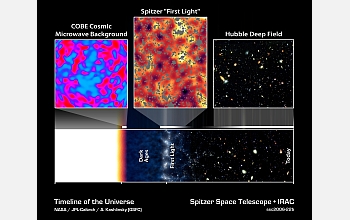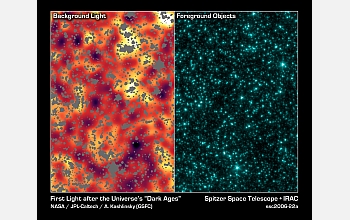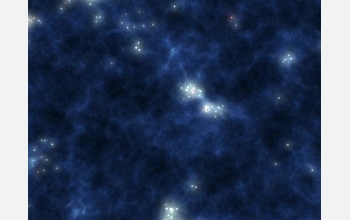All Images
News Release 06-175
Universe's Oldest Objects Emerge from the Background
Faint cosmic glow appears to be remnant radiation from first stars or black holes born in our universe
This material is available primarily for archival purposes. Telephone numbers or other contact information may be out of date; please see current contact information at media contacts.
After several image processing steps, the glow from what may be the oldest large objects in the universe stands out from "light pollution" pouring out from other objects of the unverse. Each animation frame depicts telescope data from the same infrared wavelength and covers the same stretch of sky 60-million light years by 100-million light years across, with progressive changes reflecting additional steps in the analysis. The first frame shows the original data collected by NASA's Spitzer Space Telescope at a wavelength of 3.6 microns (millionths of a meter), while the second frame shows the data after the researchers masked out the most apparent stars, galaxies and other sources. The next several frames reflect the researchers' painstaking removal of the remaining faint, ordinary galaxies to create a refined data set, from which the team created a progressively smoother image--through processing vaguely akin to removing the snow from a poor television image--to display the cosmic background glow not attributed to the stars and galaxies. According to the researchers, the remaining light-orange patches are likely the glow produced by the first luminous objects from the first billion years of the Universe's evolution.
Credit: A. Kashlinsky et al.; Nicolle Rager Fuller, National Science Foundation; NASA/JPL-Caltech/GSFC
Instruments on NASA's Spitzer Space Telescope capture multiple light wavelengths on multiple channels. This animation depicts data from a channel collecting light with wavelengths of 4.5 microns (millionths of a meter). The right side of the 3.6-micron animation overlaps with the left side of the 4.5-micron animation. The similarity of the overlapping structures suggests that the glowing arises from true objects, not artifacts from the light-collecting instrument.
Credit: A. Kashlinsky et al.; Nicolle Rager Fuller, National Science Foundation; NASA/JPL-Caltech/GSFC

This artist's timeline chronicles the history of the universe, from its explosive beginning to its mature, present-day state.
Astronomers do not know if the very first objects were either stars or quasars. The first stars, called Population III stars (our star is a Population I star), were much bigger and brighter than any in our nearby universe, with masses about 1,000 times that of our sun. These stars first grouped together into mini-galaxies. By about a few billion years after the Big Bang, the mini-galaxies had merged to form mature galaxies, including spiral galaxies like our own Milky Way. The first quasars ultimately became the centers of powerful galaxies that are more common in the distant universe.
Credit: NASA/JPL-Caltech
Download the high-resolution JPG version of the image. (2.5 MB)
Use your mouse to right-click (Mac users may need to Ctrl-click) the link above and choose the option that will save the file or target to your computer.

The right panel is an infrared image from NASA's Spitzer Space Telescope of stars and galaxies in the Ursa Major constellation. The image covers a region of space so large that light would take up to 100 million years to travel across it. The left panel is the same image after stars, galaxies and other sources were masked out. The remaining background light is from a period of time when the universe was less than 1 billion years old, and most likely originated from the universe's first groups of objects -- either huge stars or voracious black holes. Darker shades in the image on the left correspond to dimmer parts of the background glow, while yellow and white show the brightest light.
Credit: NASA/JPL-Caltech/GSFC
Download the high-resolution JPG version of the image. (3.8 MB)
Use your mouse to right-click (Mac users may need to Ctrl-click) the link above and choose the option that will save the file or target to your computer.

View Video
This artist's animation illustrates the universe's early years, from its explosive formation to its dark ages, to its first stars and mini-galaxies.
Credit: NASA/JPL-Caltech


